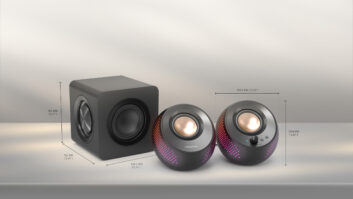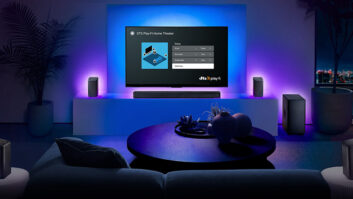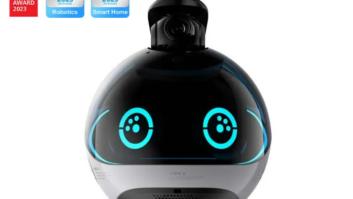CALABASAS, CALIF. – DTS:X’s ability to fix consumers’ real-world problems puts it ahead of rival nextgeneration surround technologies, DTS executives contended.
The executives cited DTS:X’s ability to adapt to speaker configurations optimized for Dolby Atmos and Auro 3D surround, correct for imperfect speaker placement, and potentially let consumers improve dialog intelligibility by raising dialog levels without raising the level of other center-channel sounds.
Object-based surround formats such as DTS:X more accurately conveys fluid movement in soundtracks by “moving sound objects to and through specific locations within, in front of, behind, above and beside the audience, precisely where the mixer placed them,” DTS said. DTS’s implementation supports up to 96kHz audio for object mixes and supports 192kHz stereo and multichannel mixes.
During presentations to the press, DTS executives also revealed that:
• DTS:X-equipped audio/video receivers (AVRs) will roll out starting in the summer, and models priced down to $599 will appear this year.
• DTS is “confident” that DTS:X will appear this year on Blu-ray discs and on cinema soundtracks for playback in movie theaters.
• The first U.S. movie theaters will be outfitted with DTS:X playback equipment in the spring.
• Work is underway to incorporate the technology in streaming services.
Bill Neighbors, DTS’s cinema initiatives VP, also said that delivering virtual height information through a standard 5.1-speaker system is “way do-able” but won’t appear in the first round of DTS:X home products.
DTS:X soundbars “are on the roadmap,” added Dave Casey, DTS:X program manager. During an extensive Q&A, DTS personnel championed DTS:X’s advantages of flexibility and interactivity over rival next-generation surround formats:
Speaker flexibility: DTS:X allows for the placement of home-theater speakers virtually anywhere in a room or cinema, executives said in drawing a distinction with Dolby Atmos object-based surround and Auro- 3D surround. DTS:X enables “optimized playback on a multitude of speaker layouts with any number of speakers,” supporting “any speaker configuration within a hemispherical layout based around the listening position in the room,” company literature added.
As a result, DTS:X-equipped AVRs and AVPs will remap DTS:X soundtracks to work optimally with speaker configurations intended for Atmos and Auro 3D playback, said Casey. Dolby Atmos object-based surround and Auro-3D channel-based surround don’t offer a similar capability, suppliers said.
Remapping includes the ability to remap DTS:X height information to Dolby Atmos height-speaker modules, which can be placed on top of left-right and surround speakers to bounce height sounds off ceilings.
The implementation of these capabilities is left up to audio manufacturers, but DTS has received “no feedback that AVR companies won’t implement them,” Casey said.
Remapping any sound object to any speaker location “is a huge selling feature for exhibitors [cinemas] as well as for consumers whose living rooms are not built purely for sound,” Casey said.
Cinemas can reuse speaker configurations optimized for Auro 3D or Dolby Atmos, including their height speakers, to deliver DTS:X’s benefits, Casey said. That reduces those cinemas’ DTS:X-implementation costs to a DTS:X renderer priced at $5,000 to $6,000, said Neighbors. Cinemas adding Atmos and DTS:X for the first time, however, would also have to rewire side-wall speakers to deliver discrete sounds.
Interactivity: Because dialog is treated as a separate audio object, consumers could select the dialog object and raise the dialog level to enhance dialog intelligibility without raising the level of other sounds. Content creators, however, have to enable that feature in their content.
Although content creators might be reluctant to hand over creative control to consumers, they’ll be able to sell a lot for discs if they enable the feature, said Randy Smith, mobile, PC and connected- home solutions senior VP.
Consumers could use the feature to raise dialog levels to improve intelligibility during noisy passages without raising the level of other sounds. The feature would be particularly useful for latenight viewing when other people are trying to sleep.
The capability is superior to other technologies that simultaneously raise dialog along with other center-channel sounds, the company said.
The technology, however, won’t let consumers select individual voices to delete.
Home-audio products available in 2015 will incorporate dialog control, and future products could incorporate enhanced interactivity.
Interactivity, for example, could be applied to future TV-sports broadcast. Consumers could opt to listen to the voice of the TV announcer or the microphones of coaches or players. The capability could be delivered by broadcasters that adopt any object-based audio format because the capability can be separated from DTS:X.
Other enhancements: Also unlike Atmos and Auro 3D, DTS:X corrects for imperfect speaker placement, delivering accurate placement of sound objects with seamless panning between speakers even if, for example, a left-front speaker is placed farther to the left of the display than the right speaker is to the right of the display.
Even 5.1- and 7.1-channel home-theater speaker systems lacking height speakers will benefit from DTS:X decoding, Casey said. Through 5.1- and 7.1-speaker configurations, DTS:X decoders will deliver more control over sounds than earlier surround formats, allowing for smoother panning around listeners, he explained. The proximity of sounds, however, would still be set at the distance of the speakers from listeners, so a sound object couldn’t move closer and farther away from a listener in a 5.1- or 7.1-speaker home-theater system.
Also with DTS:X decoding and a traditional 5.1- and 7.1-speaker system, users will be able to control dialog levels without changing the level of other sounds, if the content creator allows it, Casey added.













